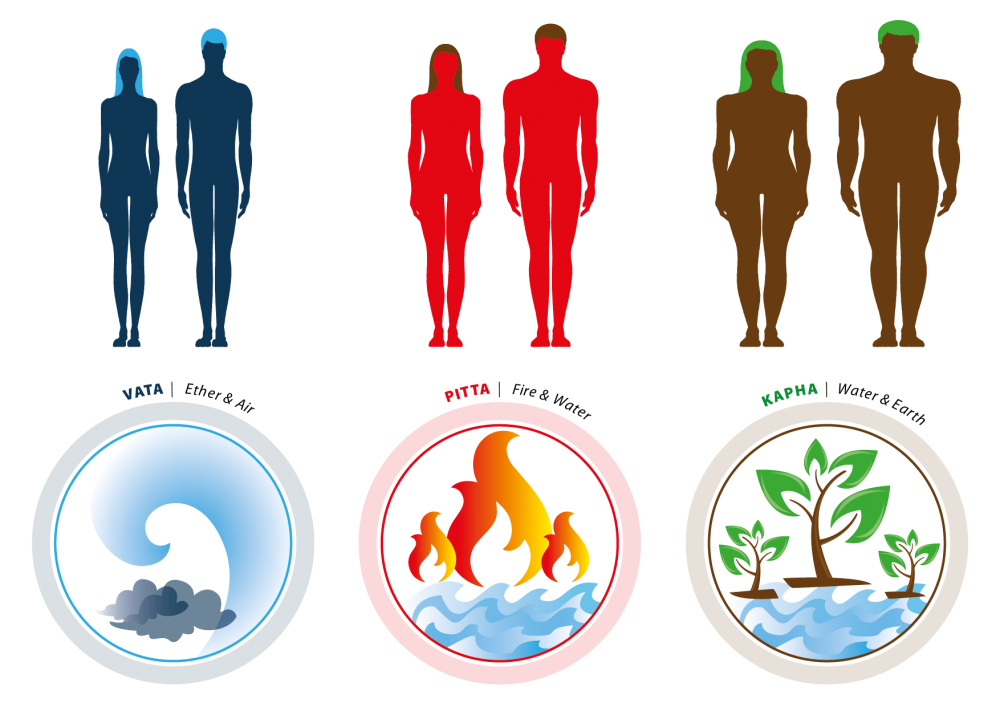Ayurveda, which derives from ancient Vedic scriptures, is a 5,000 year-old medical ideology and philosophy based on the idea that we are all made up of different types of energy.
There are three Doshas in Ayurveda that describe the dominant state of mind/body: Vata, Pitta, and Kapha. While all three are present in everyone, Ayurveda suggests that we each have a dominant Dosha that is unwavering from birth, and ideally an equal (though often fluctuating) balance between the other two. If Doshas are balanced, we are healthy; when they are unbalanced, we develop a disorder commonly expressed by skin problems, impaired nutrition, insomnia, irritability, and anxiety.
Vata, Pitta, and Kapha are all important to our biology in some way, so no one is greater than, or superior to, any other. Each has a very specific set of basic functions to perform in the body.
That said, when the Doshas are out of control, our wellbeing can be damaged. However, before we get into the particulars of each of the three Doshas, it is helpful to understand their basic nature and their wider function in the natural world.
Throughout Ayurveda, the most basic building blocks in the material world are the five elements: space, air, fire, water, and earth.
Vata is characterized by the mobile nature of Air (Wind) energy.
Pitta embodies the transformative nature of Fire energy.
And Kapha reflects the binding nature of Water energy.

The elements of the earth and water combine with the Kapha. Kapha then unites properties such as heavy, slow, and steady, but also soft, thick, hard, and cold. In the body, Kapha is liable for solidity and all structures as well as for the right volume of body fluids.
Kapha controls both the structure and lubrication in the mind and body. It regulates the weight, growth, lubrication of the joints and lungs, and the creation of all seven tissues—nutrient fluids, blood, at, muscles, bones, marrow, and reproductive tissue. Protection is the primary feature of Kapha.
They’re calm, rooted, and genuine while Kaphas are in harmony. If Kaphas get out of control, they binge-eat and under-exercise, triggering weight gain and diabetes.
What’s The Meaning of Kapha?

Kapha stems from the elements of Earth and Water and translates as “that which sticks.” It is the strength of building and lubrication that gives the body the physical form, structure, and smooth functioning of all its parts. Kapha may be thought of as the body’s essential cement, glue, and lubrication in one. The unofficial Kapha Dosha mascot is an elephant.
Just as a nourishing rainstorm can turn into a rampant flood, the body’s fluids can flood the body’s tissues, contributing to a heavy dampness that weighs down the body and clouds the mind.
Kapha is the energy that shapes the structure of the body—bones, muscles, tendons—which provides the “glue” that binds the cells together, made by earth and water. Kapha provides water to all parts and systems of the body. It lubricates the joints, moisturizes the skin, and maintains immunity. In balance, Kapha is expressed as compassion, quietness, and forgiveness. Out of balance, this leads to addiction, greed, and envy.
Kaphas are calm, rooted, and genuine while in harmony. If Kapha get out of control, they binge-eat and under-exercise, triggering weight gain and diabetes.
Kapha Dosha is the power of stability due to the rooted, stable elements that create it. Kapha types represent earth and water in its physical, mental, and emotional being. The body of Kapha types is strong and often stocky. It’s really easy for Kapha types to add weight, and it’s always hard for them to lose weight.
They have major features: dense hair, large eyes, and thick lips. The Kapha persona is sweet, caring, and faithful. They’re the ones at the group or social event to make sure everybody else is all right. They’re trying to make sure your drink is finished; you’ve eaten, you’re not either too hot or cold. Kapha types are often strong, calm, and regular. The unofficial Kapha Dosha mascot is an elephant. They walk steadily, open their hearts, and have innate respect towards others.
Like Earth’s stability, the Kapha personality holds peaceful, serene strength. A patient nature, love, and well-grounded beliefs are the distinguishing virtues that make the Kapha individual a faithful, true friend.
The complexion of the Kapha is pale, soft, and cool. Rich red and purple warm their cool skin, and garnets and rubies are the height of your strength and courage. The gentle manner of Kapha is charming, not to mention soothing and understanding. A quick massage with heated oil, some energetic music with a fast rhythm and a high volume, and Kapha would be up and moving again in no time.
According to Ayurveda, Kapha usually has a structure that is vulnerable to weight gain, sometimes even with a regular diet. Kapha skin is normally Oily, the hair appears to be dense and lustrous, but is susceptible to oiliness that needs to be controlled.
Symptoms of Kapha Dosha Imbalance:
Physical:
• Mucoid diarrhea
• Pre-diabetes
• Fatty buildup in the arteries
• Hay fever
• Cold/cough/runny nose
• Excessive mucous
• Slow/sluggish bowel movements
• Impaired appetite
• Lack of energy
• Cold sweats
• Excessive urination
• Excess ear wax
Behavioral:
• Ignorance
• Greed
• Depression
• Stubbornness
• Emotional overeating
Do You Need To Balance Kapha?
Ask these questions to see if you have to manage Kapha:
1. Do you sleep for a lot of hours, yet wake up unrefreshed?
2. Do you feel stiff and sluggish, particularly in the morning?
3. Do you experience congestion?
4. Are your skin and your hair oily?
5. Do you think you’re possessive and over-attached?
6. Do you have a propensity to be overweight?
7. Do you have sinus problems?
8. Do you feel tired, complacent?
If you replied “YES” to any of these issues, you have to balance your Kapha Dosha.
So How To Balance Kapha Dosha?
1. Add Tastes That Favors (Prefer Pungent, Astringent, and Bitter tastes)
2. Restore and Maintain Balance
3. Stay Warm and Dry
4. Eat for Your Type
5. Seek Newness
6. Consume Herbs
Tastes That Pacify Kapha
Emphasize
Pungent
Many spices have a pungent taste and are Kapha pacifying due to their hot and dry properties. Pungent taste is a mixture of fire and air.
• Pungent is a hot, spicy taste present in chilies, radishes, turnips, raw onions, and most spices. In fact, most spices are incredibly pacifying—we’ll see them in the list of Kapha-Pacifying Foods.
• The pungent taste is light, hot, rough, and dry—all great for Kapha. Essentially, if you like extremely hot or spicy dishes, go for it, and even if you don’t, prefer a wide variety of milder spices in your dish—cardamom, cloves, cinnamon, cumin, ginger, garlic, paprika, and turmeric.
• The pungent taste cleans the mouth and clears the senses. This promotes digestion, liquefies secretions, cleanses the body’s channels, induces sweating, and thins the blood.
Bitter
The bitter taste is cooling, rough, drying, light, and reducing to Kapha. This has all the attributes that help to pacify Kapha. This is usually missing in our diet regardless of its palatable taste.
It can hence also come in handy when there is an aggravation of Kapha due to excess Kapha generating food that induces indigestion.
Spices such as turmeric and fenugreek seeds and leaves will offer a bitter taste to our food whenever it is needed. Constitutionally, the bitter taste is a mixture of air and space.
• The bitter taste predominates in bitter greens (such as kale, dandelion greens, collard greens, etc.) and is also present in bitter melon, Jerusalem artichokes, burdock root, eggplant, dark chocolate, and Kapha-pacifying spices such as cumin, neem leaves, saffron, and turmeric.
• The bitter taste is rough, drying, light, and generally reducing—all the qualities that benefit Kapha, but it’s also cooling, so it is important to add some warm spices to the bitter food.
• Bitters disinfect the pallet and enhance the sensation of taste. They tone the skin and muscles, enhance appetite, facilitate digestion, and help to absorb moisture, lymph, muscle fat, adipose tissue, and sweat.
Astringent
The astringent taste is dry, cold, and heavy in nature, but mildly pacifies Kapha due to its drying properties. Triphala, artichoke, and jack fruits are examples of an astringent taste. The astringent taste is a mixture of air and earth components.
• The astringent flavor is simply a dry flavor—a chalky taste that dries the mouth and can cause it to contract (picture biting into a very green banana).
• Legumes such as adzuki beans, black-eyed peas, chickpeas, kidney beans, lentils, pinto beans, and soybeans are classically astringent in taste and very Kapha-pacifying. Some fruits, vegetables, grains, baked products, and spices are often astringent in taste—such as apples, cranberries, pomegranates, artichokes, broccoli, cauliflower, lettuce, popcorn, rice cakes, crackers, basil, coriander, dill, fennel, parsley, and turmeric.
• The astringent taste is dry, rough, mildly light, and reduces the Kapha. But like the bitter taste, it’s also cold, and it’s best to add warm herbs and spices to astringent foods. For some cases (as in the case of pomegranate), eating such foods in the warmer season makes a lot of sense.
• Kapha gains from compressing, absorbing, and the essence of the astringent taste which often helps tone body tissues and utilizes excess fluid.
Minimize
Sweet
Sweet is soothing and calming which, in moderation, encourages longevity, strength, and stable body fluids and tissues. The thick, greasy, wet properties tend to slow down digestion.
It is also recommended in Ayurveda to consume dessert first as an appetizer when the digestive or metabolic fire is at its peak.
Sweet taste is present in foods including most fruit, most grains, root vegetables, milk, ghee, fresh yogurt, eggs, nuts, seeds, and most oils except mustard. The sweet taste is the most potent to aggravate Kapha owing to its cooling, grounding, nourishing, strength building, and satisfying properties.
Please note that when we talk about the sweet taste we talk about foods with a naturally sweet taste and/or a sweet post-digestive effect, for example, sweet potatoes, white rice, and wheat. Constitutionally, the sweet taste has the elements of Kapha, water, and earth, aggravating Kapha the most.
• The sweet taste is cold, heavy, moist, oily, and Kapha-provoking, particularly in excess.
• Reduce or eliminate the consumption of processed sugar and sugary sweet products as much as possible.
• It will be difficult to eat a healthy diet and resist that sweet taste. Yet it is definitely appropriate to reduce the amounts of naturally sweet foods such as fruit, grains, root vegetables, milk, ghee, yogurt, eggs, nuts, seeds, oils, and meats.
• Sweet foods tend to exacerbate the tendency of Kapha to heaviness, obesity, lethargy, and oversleep. They can also cause excessive mucus, aggravate colds and coughs, and suppress appetite in an unhealthful manner.
Sour
Sour taste activates the mind and senses, triggers digestive juices, enhances digestion, and reduces excess wind.
If taken in abundance, it aggravates Kapha. Lemon juice, tamarind, sauerkraut, apple cider vinegar, and sour-sweet fruits such as orange, pineapple, and kiwi are a few examples. It has a mild Kapha aggravating impact due to its constitutional elements of fire (provokes Kapha) and earth (supports Kapha).
• Minimize sour foods such as vinegar, cheese, sour cream, green grapes, oranges, pineapple, and grapefruit.
• The moisturizing and oily properties of the sour taste make the Kapha worse.
• A sour taste can increase thirst, cause heaviness in the eyes, cause laxity in the body, and increase water retention or swelling.
• An occasional lemon juice or lime juice is the best way to consume the sour taste for Kaphas.
Salty
The salty taste increases hunger and digestion. This helps retain moisture and facilitates effective elimination. This also enhances the taste of other foods.
Salt in its different kinds—sea salt, rock salt, and common table salt is the main source of the salty taste. It is intended to be used in very small quantities. It is made up of fire and water and may thus exacerbate Kapha mildly.
• The salty taste is perhaps entirely derived from the salt itself.
• Like the sour taste, the moist and oily nature of salt is what causes Kapha aggravation.
• Excessive salty taste can induce water retention, high blood pressure, inflammation of the bowel, grey hair, wrinkles, excess thirst, and can interfere with the sense organs. Moreover, it tends to stimulate a strong desire for more flavors, and it may also cause insatiability and greed.
Extra Precautions:
1. Don’t work or talk on the phone while you’re eating.
2. Don’t read or watch TV.
3. Offer thanks or sit down in silence for a minute before you start eating.
4. Do not chew down the food; savor every bite and chew properly before swallowing.
5. A few sips of warm water during the meal will aid digestion, but do not consume too much of any drink.
6. At any meal, do not eat until you are very full. The perfect Ayurvedic portion is what you could hold with your both palms joined together. Leaving a space in your stomach after you’re finished supports digestion.
7. Once you’ve finished feeding, sit still for a couple of minutes; don’t try to perform the next task of the day instantly.




